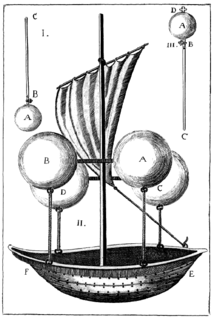A sky anchor is a system of two balloons in tandem, with a "zero-pressure" lifting gas balloon tethered to a superpressure balloon "anchor". The gas balloon is filled with a lifting gas and provides the buoyancy, while the superpressure balloon is filled with air, and pressurized to provide the desired ballast weight. In a passive sky anchor, the superpressure balloon is sealed, while in an active system, its pressure can be varied. Both versions have been tested in flight, but have had frequent failures with only occasional successful outcomes. The tandem arrangement makes launching difficult, and this complexity can lead to mission failure.

A gas balloon is a balloon that flies in the air because it is filled with a gas less dense than air or lighter than air. It is tied to a thread to prevent it from flying up in the air. It is also sealed at the bottom to ensure that the gas doesn't escape. A gas balloon may also be called a Charlière for its inventor, the Frenchman Jacques Charles. Today, familiar gas balloons include large blimps and small rubber party balloons. Blimps have displaced zeppelins as the dominant form of airship.

A superpressure balloon is a style of aerostatic balloon where the volume of the balloon is kept relatively constant in the face of changes in the temperature of the contained lifting gas. This allows the balloon to keep a stable altitude for long periods. This is in contrast with much more common variable-volume balloons, which are either only partially filled with lifting gas, or made with more elastic materials.
Because of Archimedes' principle, a lifting gas is required for aerostats to create buoyancy. Its density is lower than that of air. Only certain lighter than air gases are suitable as lifting gases.
The tandem balloon system is intended to increase the flight time of the zero-pressure balloon by damping the diurnal altitude variations caused by solar heating of the lifting gas and its subsequent expansion. As the balloons descend, the superpressure balloon's constant volume displaces a larger mass of the denser air, and becomes more buoyant. Likewise as they rise, the system displaces less air mass, limiting the ascent to prevent the lifting gas from expanding too far and escaping from the zero pressure balloon.

In meteorology, diurnal temperature variation is the variation between a high temperature and a low temperature that occurs during the same day.
The Sky Anchor system, originally developed at Texas A&M University in 1976, is usually applied to unmanned balloons, but the concept was also applied to a piloted balloon. The "Earthwinds" balloon system used a tandem balloon arrangement for a planned circumnavigation record attempt using the jet stream winds. Five attempts at the circumnavigation in the early 1990s all failed early in the flight, with the fifth abort on January 1, 1995 blamed on a failure of the lower ballast balloon.

Texas A&M University is a public research university in College Station, Texas, United States. It is a state flagship university and since 1948 is the founding member of the Texas A&M University System. The Texas A&M system endowment is one of the 10 biggest in the nation. As of 2017, Texas A&M's student body is the largest in Texas and the second largest in the United States. Texas A&M's designation as a land, sea, and space grant institution–the only university in Texas to hold all three designations–reflects a range of research with ongoing projects funded by organizations such as the National Aeronautics and Space Administration (NASA), the National Institutes of Health, the National Science Foundation, and the Office of Naval Research. In 2001, Texas A&M was inducted as a member of the Association of American Universities. The school's students, alumni—over 450,000 strong—and sports teams are known as Aggies. The Texas A&M Aggies athletes compete in 18 varsity sports as a member of the Southeastern Conference.

Circumnavigation is the complete navigation around an entire island, continent, or astronomical body. This article focuses on the circumnavigation of Earth. The first circumnavigation of Earth was the Magellan-Elcano expedition, which sailed from Seville, Spain in 1519 and returned in 1522, after crossing the Atlantic, Pacific, and Indian oceans.

Jet streams are fast flowing, narrow, meandering air currents in the atmospheres of some planets, including Earth. On Earth, the main jet streams are located near the altitude of the tropopause and are westerly winds. Their paths typically have a meandering shape. Jet streams may start, stop, split into two or more parts, combine into one stream, or flow in various directions including opposite to the direction of the remainder of the jet.












